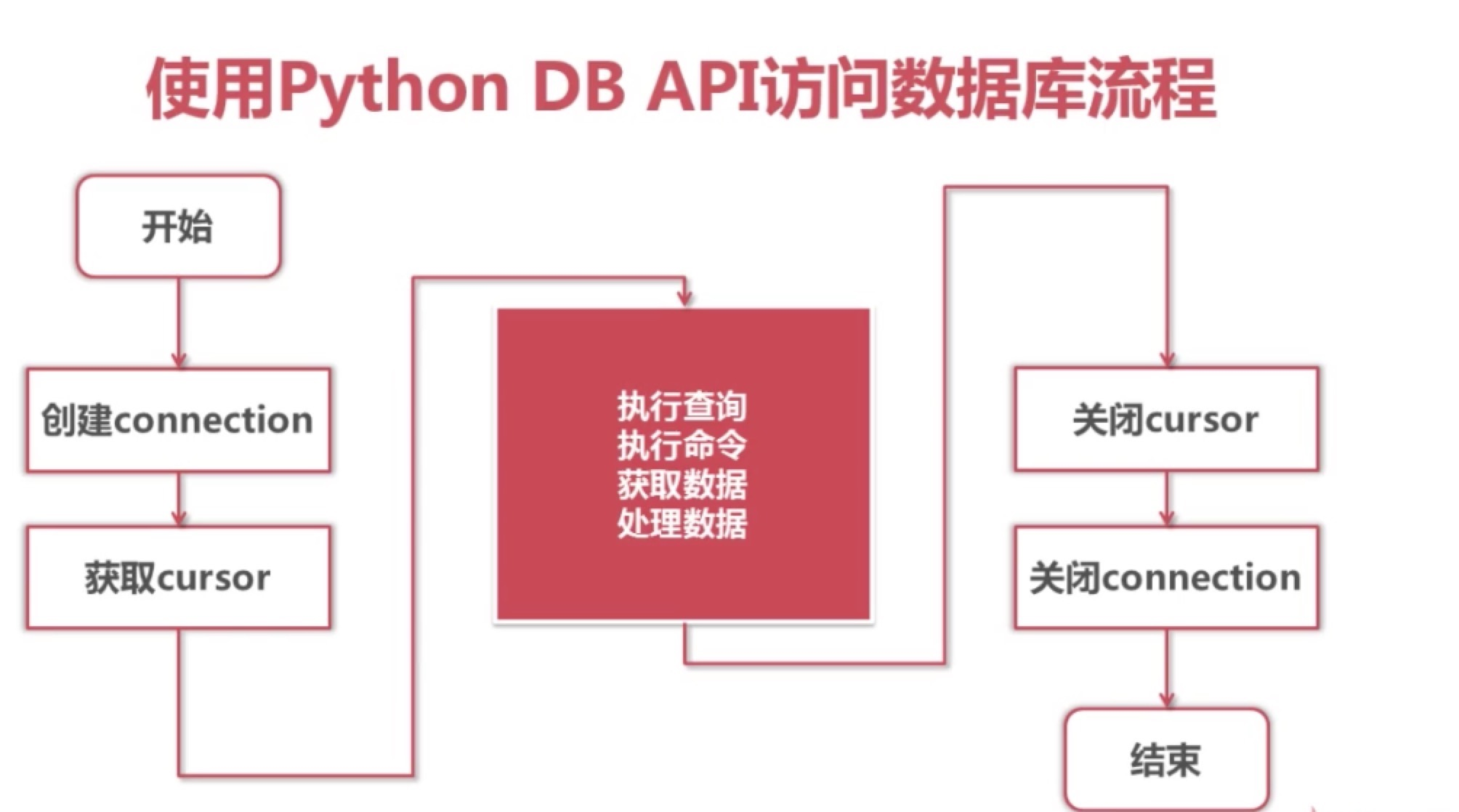一:Python操作MySQL步骤
1:Python中操作MySQL的步骤

2.引入模块
在.py文件中引入pymysql模块
import pymysql
pymysql是python的一个第三方与mysql交互的库,需要安装
pip install pymsql
3.Connection 对象
用于建立与数据库的连接
创建对象,调用connect()方法
conn = connect(参数列表)
- 参数host:连接的mysql主机,如果本机是'localhost'
- 参数port:连接的mysql主机的端口,默认是3306
- 参数database:数据库的名称
- 参数user:连接的用户名
- 参数password:连接的密码
- 参数charset:通信采用的编码方式,推荐使用utf8
对象方法:
- close()关闭连接
- commit()提交
- cursor()返回Cursor对象,用于执行sql语句并获得结果
4.Cursor()
- 用于执行sql语句,使用频度最高的语句为select、insert、update、delete
- 获取Cursor对象:调用Connection对象的cursor()方法
cs1 = conn.cursor()
对象的方法
- close()关闭
- execute(operation [, parameters ])执行语句,返回受影响的行数,主要用于执行insert、update、delete语句,也可以执行create、alter、drop等语句
- fetchone()执行查询语句时,获取查询结果集的第一个行数据,返回一个元组
- fetchall()执行查询时,获取结果集的所有行,一行构成一个元组,再将这些元组装入一个元组返回
对象的属性
- rowcount只读属性,表示最近一次execute()执行后受影响的行数
- connection获得当前连接对象
二:增删改查
1.增删改
from pymysql import * def main(): # 创建Connection连接 conn = connect(host='localhost',port=3306,database='jing_dong',user='root',password='mysql',charset='utf8') # 获得Cursor对象 cs1 = conn.cursor() # 执行insert语句,并返回受影响的行数:添加一条数据 # 增加 count = cs1.execute('insert into goods_cates(name) values("硬盘")') #打印受影响的行数 print(count) count = cs1.execute('insert into goods_cates(name) values("光盘")') print(count) # # 更新 # count = cs1.execute('update goods_cates set name="机械硬盘" where name="硬盘"') # # 删除 # count = cs1.execute('delete from goods_cates where id=6') # 提交之前的操作,如果之前已经之执行过多次的execute,那么就都进行提交 conn.commit() # 关闭Cursor对象 cs1.close() # 关闭Connection对象 conn.close() if __name__ == '__main__': main()
2.查询一条数据
from pymysql import * def main(): # 创建Connection连接 conn = connect(host='localhost',port=3306,user='root',password='mysql',database='jing_dong',charset='utf8') # 获得Cursor对象 cs1 = conn.cursor() # 执行select语句,并返回受影响的行数:查询一条数据 count = cs1.execute('select id,name from goods where id>=4') # 打印受影响的行数 print("查询到%d条数据:" % count) for i in range(count): # 获取查询的结果 result = cs1.fetchone() # 打印查询的结果 print(result) # 获取查询的结果 # 关闭Cursor对象 cs1.close() conn.close() if __name__ == '__main__': main()
3.查询多行数据
from pymysql import * def main(): # 创建Connection连接 conn = connect(host='localhost',port=3306,user='root',password='mysql',database='jing_dong',charset='utf8') # 获得Cursor对象 cs1 = conn.cursor() # 执行select语句,并返回受影响的行数:查询一条数据 count = cs1.execute('select id,name from goods where id>=4') # 打印受影响的行数 print("查询到%d条数据:" % count) # for i in range(count): # # 获取查询的结果 # result = cs1.fetchone() # # 打印查询的结果 # print(result) # # 获取查询的结果 result = cs1.fetchall() print(result) # 关闭Cursor对象 cs1.close() conn.close() if __name__ == '__main__': main()
三:参数化
sql语句的参数化,可以有效的方式sql注入攻击
此处不同于python的字符串格式化,全部使用%s占位
from pymysql import * def main(): find_name = input("请输入物品名称:") # 创建Connection连接 conn = connect(host='localhost',port=3306,user='root',password='mysql',database='jing_dong',charset='utf8') # 获得Cursor对象 cs1 = conn.cursor() # # 非安全的方式 # # 输入 " or 1=1 or " (双引号也要输入) # sql = 'select * from goods where name="%s"' % find_name # print("""sql===>%s<====""" % sql) # # 执行select语句,并返回受影响的行数:查询所有数据 # count = cs1.execute(sql) # 安全的方式 # 构造参数列表 params = [find_name] # 执行select语句,并返回受影响的行数:查询所有数据 count = cs1.execute('select * from goods where name=%s', params) # 注意: # 如果要是有多个参数,需要进行参数化 # 那么params = [数值1, 数值2....],此时sql语句中有多个%s即可 # 打印受影响的行数 print(count) # 获取查询的结果 # result = cs1.fetchone() result = cs1.fetchall() # 打印查询的结果 print(result) # 关闭Cursor对象 cs1.close() # 关闭Connection对象 conn.close() if __name__ == '__main__': main()